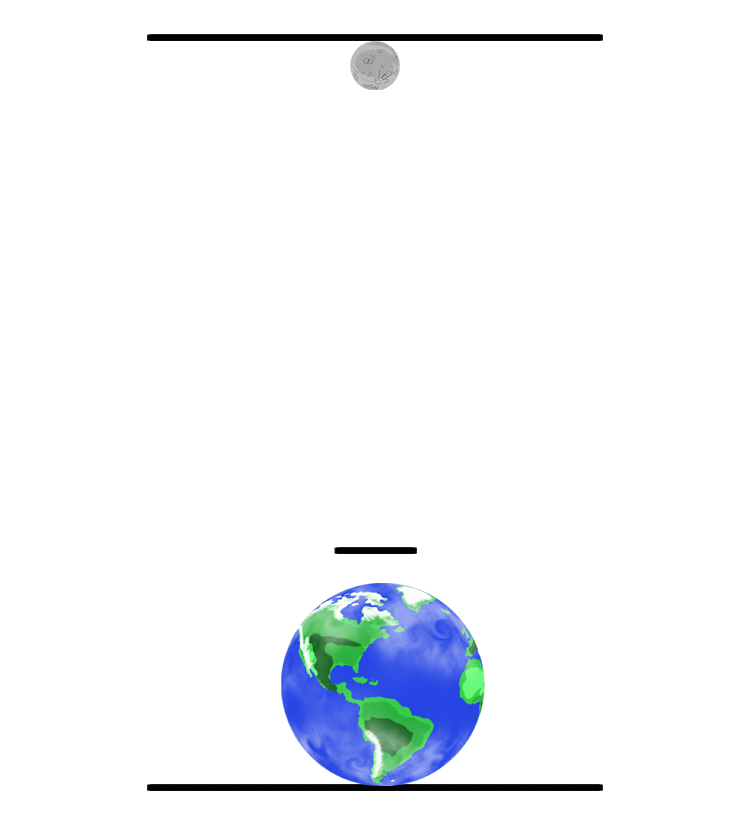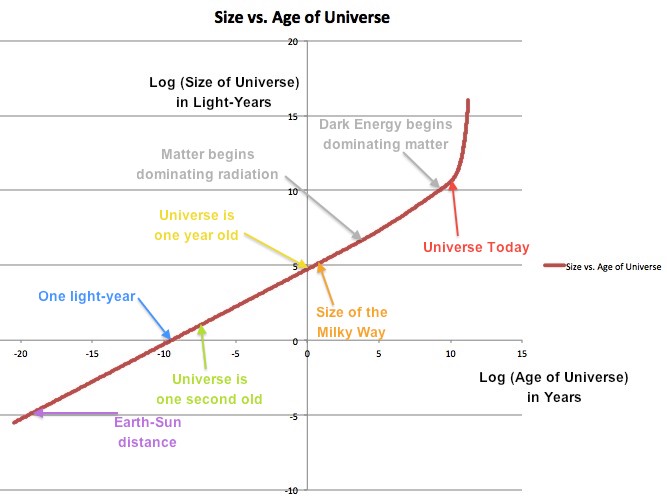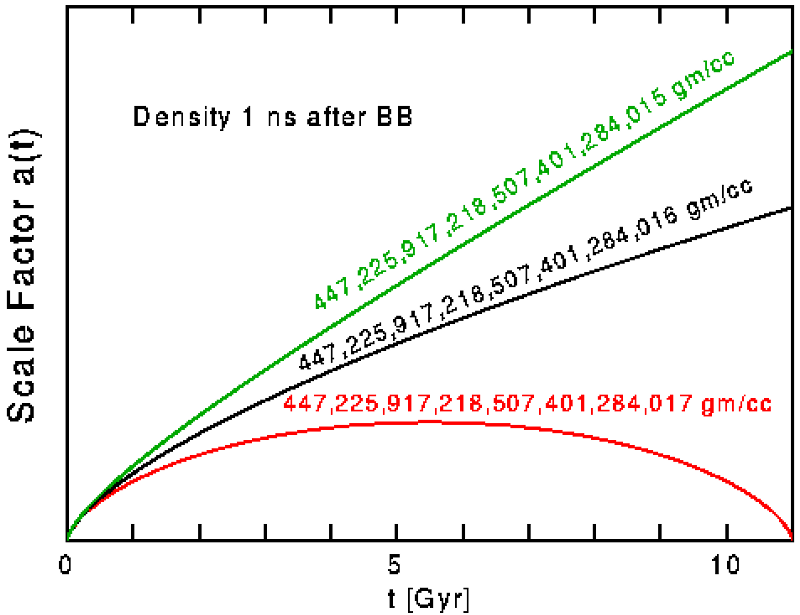Ask Ethan # 50: Why hasn’t the Universe turned into a black hole?
Considering that all this matter and all energy were so closely gathered in one place, and were so dense at the time of the Big Bang - why did the Universe not recollapse?
“Es ist immer angenehm, über strenge Lösungen einfacher Form zu verfügen.” (It is always a pleasure to have at your disposal a precise solution in a simple form)
- Karl Schwarzschild
Even if you knew all the laws of physics in all places of the Universe at any time, this would still not be enough to predict the current state of the Universe. Since, although the laws of physics set the rules for the evolution of a system, it still needs a set of initial conditions for starting. This week our edition is devoted to the question of Adreas Lauzer, who asks:
Although I have no special doubts that the Big Bang theory is correct, or, as you would say, approximates what happened well, there is one thing that I think about when I think about this part of cosmology. Is there any explanation for the fact that the Universe did not immediately turn into a black hole? I believe that its initial density was much higher than the Schwarzschild limit.
We have already discussed this question , but you need additional details and a better answer than I then gave. Let us return to the moment of birth of the most successful theory of gravity, GR, 100 years ago.

Before Einstein, the Newtonian law of world wideness was the recognized theory of gravity. All the gravitational phenomena of the Universe, from the acceleration of masses on the Earth, to the orbits of the moons around the planets and the circulation of the planets themselves around the Sun, were described by his theory. Objects exerted equal and oppositely directed attractive forces when interacting with each other, they were accelerated inversely to the mass, and the forces obeyed the universal inverse square law. By the 1900s, the law was well tested, and no exceptions were found. Well, more precisely, among thousands and thousands of successful tests, they were practically not found.

')
But for shrewd minds and those interested in details, there were a couple of problems.
1. At very high speeds, approaching the speed of light, Newtonian ideas about absolute space and time could no longer cope. Radioactive particles lived longer, distances shrank, and mass was not the main source of attraction — this honor seemed to move to energy, and mass was just one of its forms.
2. In very strong gravitational fields - at least, because of this, Mercury was a special planet in our Solar System, turning around the Sun - Newton's predictions about the gravitational behavior of objects slightly, but noticeably, differed from observations. It seemed that if one came very close to very massive sources, an additional force of attraction appeared, which Newtonian gravity did not take into account.
After all this, two developments have emerged that paved the way for a new theory that came to replace Newtonian — a brilliant but very old concept describing the principles of the work of the Universe.

The first development of scientists was that space and time, previously considered separate entities (three-dimensional space and linear time) were combined in a mathematical apparatus that created four-dimensional space-time. This was done in 1907 by Hermann Minkowski:
The views on space and time that I want to present to you have grown on the basis of experimental physics, and this is their strength. [...] Consequently, space itself, and time itself, is destined to disappear into the shadows, and only the union of the two of them will remain in the role of an independent reality.
It only worked for the flat Euclidean space, but the idea was extremely powerful from the point of view of mathematics, and all the laws of general relativity became its inevitable consequence. When this idea was applied to the problem with the orbit of Mercury, the Newtonian prediction, taking into account the new device, slightly approached the observed parameters, but still did not reach them.

The second development was done by Einstein himself, and it was the idea that space-time is not flat, but curved. And the factor determining the curvature of space-time was the presence of energy in all its manifestations, including mass. Being published in 1915, Einstein's apparatus was terribly difficult to use for calculations, but it gave all scientists tremendous opportunities for modeling physical systems at a new level of accuracy.
The space-time of Minkowski corresponded to an empty Universe, not containing energy and matter of any type.

Einstein managed to find a solution in which there was a single point mass in the Universe, with the condition that you are outside this point. It was reduced to Newtonian predictions at large distances, but gave more accurate data at small. The results not only agreed with the observation of the orbit of Mercury, which Newtonian gravity did not predict, but also allowed us to make new assumptions about the curvature of sunlight, which can be seen during a total solar eclipse — these predictions were confirmed later, during the 1919 eclipse.

But there is one more solution, unexpected and interesting, released just a few weeks after Einstein published GTR. Karl Schwarzschild worked out the details of what happens in a configuration with a single point mass of arbitrary size, and what he found was amazing:
- At large distances, Einstein's solution works, and reduces to Newtonian results.
- But very close to mass, at a distance of R = 2M in natural units, you reach a point from which nothing can escape - the event horizon.
- Moreover, everything inside the event horizon inevitably collapses to a central singularity, which is an inevitable consequence of Einstein's theory.
- And finally, any initial configuration of stationary dust, which has a zero initial velocity and does not collide with itself, regardless of the density distribution, will inevitably collapse into a stationary black hole.
This solution, the Schwarzschild metric, was the first complete and non-trivial solution of GR.

Let us remember all of the above and go to the heart of the question: how about a hot, dense early Universe, where all matter and energy, now spread over 92 billion light years of space, was contained in a volume not larger than our Solar system?

But we must bear in mind that, like Minkowski's space-time, Schwarzschild's solution is static, that is, in it the metric of space does not change over time. But there are many other solutions - de Sitter space, Friedmann-Robertson-Walker metric, describing space-time, which expand or contract.

If we started with matter and energy that were contained in the Universe in the early stages of the Big Bang, and our Universe would not be expanding, but static, and there would be no particles with non-zero speed, and the particles would not collide with each other - all this energy would form a Schwarzschild black hole very quickly, almost instantly. But in GTR there is another important hitch: in addition to the fact that the presence of matter and energy determines the curvature of space, everything that exists in this space determines the evolution of spacetime itself!

What is most surprising, we know that since the Big Bang, our Universe has only three possible options for development, depending on the matter and energy present in it and the initial rate of expansion.
- The rate of expansion might not be large enough for the amount of matter and energy that is present in it. This means that the Universe would expand for a sufficiently short period of time, reach its maximum size, and then begin to shrink. It would be incorrect, although very desirable, to say that it would collapse into a black hole, since space itself would shrink together with matter and energy, and would generate a singularity called Great Compression (Big Crunch, Big Crunch).
- On the other hand, the expansion rate could be too high for the amount of matter and energy present in the Universe. In this case, all matter and energy would diverge at a rate too high for gravity to bring together all the components of the Universe, and in most models the Universe expands too quickly to form galaxies, planets, stars, or even atoms and atomic nuclei. Such a universe would be an empty and lonely place.
- And then there is the Goldilocks zone, or the case where the Universe is just on the very edge between recollapse (what would have happened if there was at least one extra proton in it) and expansion to nowhere (if it had one less proton) and instead, it asymptotically approaches a state in which the rate of expansion drops to zero, but never turns into reverse compression.
It turns out that we live almost in the Goldilocks zone, but with the addition of a small amount of dark energy, which slightly increases the rate of expansion, and this means that, in the end, all the matter that is not connected gravitationally together will scatter to the sides and disappear into the abyss of deep space. .

What is surprising here is how many precise adjustments should happen so that the rate of expansion of the Universe and the density of matter and energy coincide so well that we either collapse right back or expand so as not to be able to form the basic building blocks for the construction of matter. The probability of this is approximately one to 10 ^ 24, and is approximately equal to the probability with which two people, by counting the number of electrons contained in them, would find out that they are identical to the electron. If we went back in time at a time when the age of the Universe was only a nanosecond from the moment of the Big Bang, we could numerically calculate how well the density and expansion rate are adjusted.

In my opinion, quite an incredible story!
And, nevertheless, this is exactly how one can describe our Universe, which did not collapse immediately, and did not expand too quickly, so that complex structures could not form in it. Instead, it gave rise to all the wonderful diversity of nuclear, atomic, molecular, cellular, geological, planetary, stellar, galactic and cluster phenomena that we can observe. It is fortunate that we exist, and that we have learned everything that we have learned, and that we are involved in the process of further knowledge: in science.

Source: https://habr.com/ru/post/394791/
All Articles